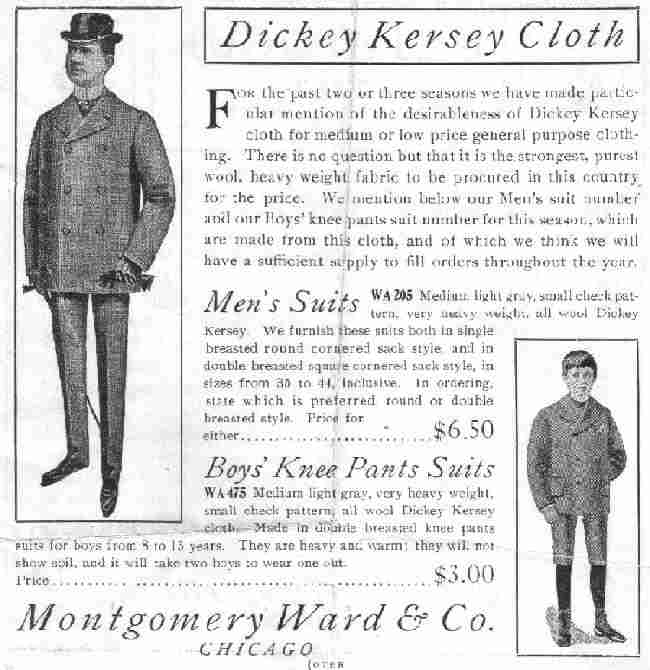
Wards: Dickey Kersey Cloth Double-breasted Knee Pants Suit (1900s)

Figure 1.-- Boy commonly wore suits in the 1900s. We note collar-buttoning suits as well as sack suits with lapels, both single- and double-breasted suits. Most boys' suits were done with kneepants, but knicker suits were also available. We note a Montgomery Ward's ad for a Dickey Kersey cloth double breasted knee pants suit. Unfortunately it is not dates. We believe it was in an early or mid-1900s catalog. Click on the image for an enlargement of the suit.
|
Boy commonly wore suits in the 1900s. We note collar-buttoning suits as well as sack suits with lapels, both single- and double-breasted suits. Most boys' suits were done with kneepants, but knicker suits were also available. We note a Montgomery Ward's ad for a Dickey Kersey cloth double breasted knee pants suit. Unfortunately it is not dates. We believe it was in an early or mid-1900s catalog.
Although the word "consumerism" has a modern ring, it was personal concern for an early consumer movement, the "National Grange of the Patrons of Husbandry," That inspired a young traveling salesman named Aaron Montgomery Ward to start the world's first general merchandise mail-order company in 1872. Aaron Montgomery Ward was born on February 17, 1844, in Chatham, New Jersey, to a family whose forebears had served as officers in the French and Indian Wars as well as in the American Revolution. Looking for something more compatible, Monty left home and followed the river to Lake Michigan and the town of St. Joseph, county seat and market for outlying fruit orchards. Chicago was the center of the wholesale dry goods trade and in the 1860s Ward joined the leading dry goods house, Field Palmer & Leiter. As a retailer, Potter Palmer had previously built a reputation for fair dealing. Ward absorbed these principles while working as a clerk for $5. The Chicago City Directories for 1868 through 1870 listed Ward as a salesman for Wills, Greg & Co. and later for Stetthauers & Wineman, both dry goods houses. In 1870, after canvassing territory in Illinois, Iowa, Missouri, Ward was again footloose. The plan shaping in Ward's mind was to buy goods at low cost for cash. By eliminating intermediaries, with their markups and commissions, and cutting selling costs to the bone, he could offer goods to people, however remote, at appealing prices - for cash. Since its founding in 1872, the company has literally "grown up with America" and has had a major impact on the shopping habits of a nation of consumers. Montgomery Ward & Co. discontinued its catalog operations in 1985 as part of its restructuring effort to change itself into a modern, competitive chain of value-driven specialty stores, a move which for a time saved the company. week.
Chronology
The page here is not dated. The fact that hotographs are used I think means it was dated after the turn of the century. We think that it was, however, very early in the 1900s, probably 1900-05. By 1910 we begin to see more knickers. One clue here is the notation, "CATALOGUE W IS NOW READY TO SEND OUT" may help track the year.
says
Dickey Kersey Cloth
We are not sure what "dickey" meant here. Kersey cloth was, however, a well known fabric. It is named after the nglish village of Kersey where cloth was made in the 11th century. Kersey cloth was used variously. One meaning was a ribbed woolen fabric that was used mostly for hosiery and inexpensive work clothes. It was also used for a heavy fabric made of wool or cotton. This fabric was commonly used for both uniforms and coats. Poor quality or reused wool might be used to make Kersey cloth. It was said, however, to similar to beaver which was quite expensive. Kersey cloth was fulled more with a shorter nap. It was also more lusterous. We believe that the image of Kersey cloth as an inexpensive fabric was primarily pronounced in Britain. American consumers may have seen it as a British fbric and thus as a selling point. Note how Kersey cloth appears in large letters in the headline. I think such prominent placement in advertising would have been less likely in Britain.
Garments
The boy's suit here is a double-breasted knee pants suit. The jacket has a lapel cut high. Knee pants were the most popular style for American boys at the time. This particular suit was made in sizes 8-15 years. We have seen knee pants suiys made for even older boys. The ad was captioned, "Boys' Knee Pants Suits". The ad copy read, "WA 475 Medium light gray, very heavy weight, small check pattern, all wool Dickey Kersey cloth. Made in double breasted knee pants suits fi=or boys from 8 to 15 years. They are heavy and warm; they will not show soil, and it will take two boys to wear one out. Price ... $3.00."
HBC

Navigate the Boys' Historical Clothing catalog/magazine pages:
[Return to the Main American mail order 1900s (decade) page]
[Return to the Main American mail order 1900s (century) page]
[Main photo/publishing page]
[Store catalogs]
[Fashion magazines]
Navigate the Boys' Historical Clothing Web Site:
[Introduction]
[Activities]
[Biographies]
[Chronology]
[Clothing styles]
[Countries]
[Fabrics A-L]
[Bibliographies]
[Contributions]
[Essays]
[FAQs]
[Glossaries]
[Satellites]
[Tools]
[Boys' Clothing Home]
Navigate the Boys' Historical Clothing Web Site:
[Sailor hats]
[Fauntleroy blouses]
[Sailor suits]
[Buster Brown suits]
[Eton suits]
[Rompers]
[Tunics]
[Smocks]
[Pinafores]
[Kneepants]
[Long stockings]
[Underwear]
[Posture devices]
Created: 8:12 PM 6/2/2006
Last updated: 8:12 PM 6/2/2006



